B) False
Correct Answer

verified
Correct Answer
verified
Multiple Choice
In a monopolistically competitive market,
A) strategic interactions among the firms are very important.
B) the threat of entry by new firms is not an important consideration.
C) the attainment of a Nash equilibrium is an important objective.
D) firms may enter even though they will earn zero economic profit in the long run.
F) A) and D)
Correct Answer

verified
Correct Answer
verified
Multiple Choice
A firm produces the welfare-maximizing level of output
A) only when the market is perfectly competitive.
B) only when the market is a monopoly or monopolistically competitive.
C) only when the market is monopolistically competitive or perfectly competitive.
D) when the market is perfectly competitive, monopolistically competitive, or monopolistic.
F) B) and C)
Correct Answer

verified
Correct Answer
verified
True/False
In the long run, monopolistically competitive firms produce where demand equals average total cost.
B) False
Correct Answer

verified
Correct Answer
verified
Multiple Choice
Table 16-5
This table shows the demand schedule, marginal cost, and average total cost for a monopolistically competitive firm.  -Refer to Table 16-5. Which of the following statements regarding this monopolistically competitive firm is correct?
-Refer to Table 16-5. Which of the following statements regarding this monopolistically competitive firm is correct?
A) New firms will enter this market in the long run since firm profits are greater than zero.
B) Firms will leave this market in the long run since firm profits are less than zero.
C) This firm is currently in long-run equilibrium.
D) This firm is currently in long-run equilibrium, and the firm is producing its efficient scale of output.
F) None of the above
Correct Answer

verified
Correct Answer
verified
Multiple Choice
Firms in industries that have competitors but do not face so much competition that they are price takers are operating in either a(n)
A) oligopoly or perfectly competitive market.
B) oligopoly or monopoly market.
C) oligopoly or monopolistically competitive market.
D) monopoly or monopolistically competitive market.
F) A) and C)
Correct Answer

verified
Correct Answer
verified
Multiple Choice
In perfect competition as well as in monopolistic competition,
A) marginal revenue is equal to price for each firm.
B) profit is positive in a long-run equilibrium for each firm.
C) entry and exit by firms are restricted.
D) there are many firms in a single market.
F) C) and D)
Correct Answer

verified
Correct Answer
verified
Multiple Choice
Figure 16-3
This figure depicts a situation in a monopolistically competitive market. 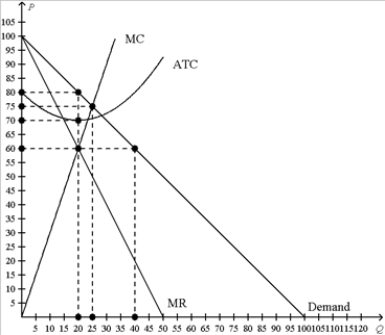 -Refer to Figure 16-3. This firm is operating
-Refer to Figure 16-3. This firm is operating
A) in the short run and earning a positive economic profit.
B) in the short run and breaking even.
C) in the long run and earning a positive economic profit.
D) in the long run and incurring and economic loss.
F) B) and C)
Correct Answer

verified
Correct Answer
verified
Multiple Choice
In both perfect competition and monopolistic competition, each firm
A) has some monopoly power.
B) sells a product that is at least slightly different from those of other firms.
C) faces a downward-sloping demand curve.
D) has many competitors.
F) A) and C)
Correct Answer

verified
Correct Answer
verified
Multiple Choice
If advertising reduces a consumer's price sensitivity between identical goods, it is likely to
A) increase the elasticity of demand for differentiated products.
B) enhance competition and encourage more product diversity.
C) reduce competition and reduce social welfare.
D) encourage the consumption of all homogenous goods.
F) A) and B)
Correct Answer

verified
Correct Answer
verified
Multiple Choice
Table 16-6
Beatrice's Birthday Cakes is one bakery among many in the market for birthday cakes. The following table presents cost and revenue data for birthday cakes at Beatrice's.  -Refer to Table 16-6. Suppose the government forced Beatrice's to produce at the efficient scale of output. Who would be better off as a result of this policy? Who would be worse off as a result of this policy?
-Refer to Table 16-6. Suppose the government forced Beatrice's to produce at the efficient scale of output. Who would be better off as a result of this policy? Who would be worse off as a result of this policy?
A) Beatrice's would be better off; consumers would be worse off.
B) Consumers would be better off; Beatrice's would be worse off.
C) No one would be better off; consumers would be worse off.
D) No one would be better off; no one would be worse off.
F) All of the above
Correct Answer

verified
Correct Answer
verified
Multiple Choice
Figure 16-1 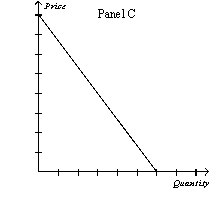
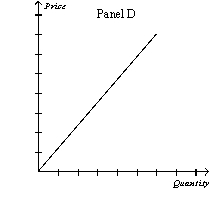
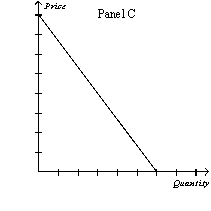
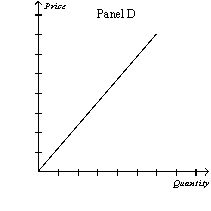 -Refer to Figure 16-1. Which of the graphs illustrates a relatively elastic, though not perfectly elastic, demand curve consistent with a market that has many substitute products?
-Refer to Figure 16-1. Which of the graphs illustrates a relatively elastic, though not perfectly elastic, demand curve consistent with a market that has many substitute products?
A) Panel A
B) Panel B
C) Panel C
D) Panel D
F) B) and C)
Correct Answer

verified
Correct Answer
verified
Multiple Choice
A monopolistically competitive market is characterized by
A) free entry, but not differentiated products.
B) differentiated products, but not long run profits.
C) long run profits, but not many firms.
D) many firms, but not free entry.
F) A) and C)
Correct Answer

verified
Correct Answer
verified
Multiple Choice
Among arguments for and against advertising, both sides agree that advertising leads to
A) higher prices and less competitive markets.
B) higher prices and more competitive markets.
C) lower prices and more competitive markets.
D) None of the above is correct. The debate fails to resolve the question of advertising's effect on prices and competition.
F) B) and C)
Correct Answer

verified
Correct Answer
verified
Multiple Choice
Which of the following statements is correct?
A) Cigarettes are likely to be produced in a monopolistically competitive industry.
B) Novels are likely to be produced in a monopoly industry.
C) Movies are likely to be produced in a monopolistically competitive industry.
D) Milk is likely to be produced in an oligopoly industry.
F) B) and C)
Correct Answer

verified
Correct Answer
verified
Multiple Choice
Figure 16-11 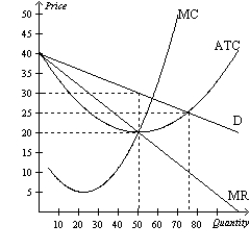 -Refer to Figure 16-11. The profit for this firm is
-Refer to Figure 16-11. The profit for this firm is
A) $375.
B) $500.
C) $1000.
D) $1250.
F) B) and C)
Correct Answer

verified
Correct Answer
verified
Multiple Choice
A firm can earn economic profits in the long run
A) only when the market is a monopoly.
B) only when the market is a monopoly or monopolistically competitive.
C) only when the market is monopolistically competitive or perfectly competitive.
D) when the market is perfectly competitive, monopolistically competitive, or monopolistic.
F) A) and C)
Correct Answer

verified
Correct Answer
verified
Multiple Choice
Scenario 16-2 Suppose market demand for a product is given by the equation P = 20 - Q. For this market demand curve, marginal revenue is MR = 20 - 2Q. -Refer to Scenario 16-2. If the marginal cost of producing this good is 0, what price would a profit-maximizing monopolist charge for the product?
A) P = 0
B) P = 5
C) P = 10
D) P = 20
F) A) and D)
Correct Answer

verified
Correct Answer
verified
Multiple Choice
Which of the following statements is correct?
A) The more similar Firm A's product is to Firm B's product, the more likely Firm A is to advertise.
B) Monopolistically competitive firms advertise in order to increase the elasticity of the demand curve they face.
C) According to the signaling theory, the more product information an advertisement contains, the more effective it is.
D) Brand names may help consumers if they provide information about the quality of a product when acquiring such information is difficult.
F) A) and C)
Correct Answer

verified
Correct Answer
verified
True/False
A firm in a monopolistically competitive market can earn short-run profits but not long-run profits.
B) False
Correct Answer

verified
Correct Answer
verified
Showing 181 - 200 of 580
Related Exams